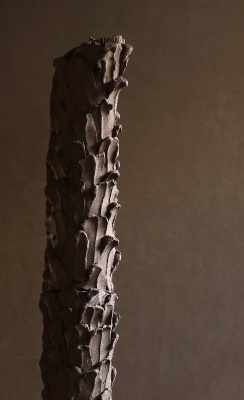Descripción de la Exposición
Com curadoria de Hércules Goulart Martins, a exposição reúne, a partir do dia 12, obras de Adriano Amaral, Ana Mazzei, Charbel-joseph H. Boutros, Daniel de Paula, Débora Bolsoni, Goran Petercol, Ícaro Lira, Lais Myrrha, Ricardo Basbaum, Michael E. Smith e Rafael França
Sempre um ponto de identidade, sempre distinção é um fragmento do poema Canto de mim mesmo, de Walt Whitman, e também o título escolhido pelo curador Hércules Goulart Martins para a exposição coletiva marcada para abrir dia 12 de novembro na Galeria Jaqueline Martins, em São Paulo. A mostra reúne obras de Adriano Amaral, Ana Mazzei, Charbel-joseph H. Boutros, Daniel de Paula, Débora Bolsoni, Goran Petercol, Ícaro Lira, Lais Myrrha, Michael E. Smith, Ricardo Basbaum e Rafael França, e, convida o visitante a integrar e compor junto com as imagens uma nova percepção a partir da locomoção pelo espaço.
“A ideia é abrigar diversas estratégias conceituais e processos, e tornar, desse modo, manifesto seus pontos de correspondências ou conexões. Dada a particularidade dos trabalhos, cada qual apresentará uma perspectiva diferente de cada um dos pontos de contato. É como se cada um desses pontos se tornasse uma constelação de diferentes perspectivas. Tempo, interação, repetição, impermanência, tanto o que é visível quanto o que é impalpável, tudo acaba se cruzando numa confluência. Isso acresce novos significados, percepções e livres associações” , diz Hércules Goulart Martins.
Entre os formatos expostos, estão instalações, vídeos, diagramas, desenhos, objetos escultóricos, proposições participativas e site specific. A partir destes e de suas substâncias, instaura-se um jogo incessante de convergências e diferenças. Abordagens e tópicos diversos como agenciamento, tempo, enfoque sócio-político, iteração, impermanência, público, doméstico, visível e impalpável entrecruzam-se continuamente, acrescendo novas interpretações e possibilitando livres analogias.
O vídeo After a deep sleep (Getting out), do artista Rafael França (1957-1991), caracteriza bem essa ideia. O uso experimental de lapsos de tempo, ironia, interpolação de planos cromáticos, inversão temporal e ruptura do liame entre imagem e som, gera uma indefinição. Mesclam-se aspectos muito peculiares à Nouvelle Vague e ao Slapstik. As convenções que demarcam os limites entre still, fotografia realista, animação e imagem cinemática resultam inapropriadas. A incongruência sonora introduz diferentes temporalidades e cria uma atmosfera esquizoide, que tinge e se sobrepõem à dinâmica da geometria espacial. A reverberação repetida de uma espécie de after-sound cerca e engaja o espectador como co-protagonistas, à semelhança da performer, de uma trama onde a arquitetura doméstica é experenciada como uma situação insólita e de confinamento. “É necessário notar aqui que a produção desse vídeo se deu um ano antes do término, dito como oficial, da ditadura militar em 1985”, lembra Hércules.
A configuração espacial produzida pelo posicionamento das obras resultará numa estrutura aberta a fim de propiciar um envolvimento mais direto, ativo e fluído, menos distante e contemplativo. “A exposição nasce a partir do conceito de rizoma delineado pelos filósofos Gilles Deleuze e Félix Guattari em Mil-Platôs, onde aludem às noções de multiplicidade, conexão e heterogeneidade. Esta vinculação tem como fundamento o princípio do vir-a-ser forjado na inter-relação de alteridades. Nesta dinâmica relacional, dois organismos dissímeis iniciam um processo de mútua reciprocidade e interpolinização, e vêm assim a gerar juntos uma multiplicidade, ou seja, uma singularidade múltipla em si”, completa o curador.
Opening on 12 November and curated by Hércules Goulart Martins, the exhibition gathers works by Adriano Amaral, Ana Mazzei, Charbel-joseph H. Boutros, Daniel de Paula, Débora Bolsoni, Goran Petercol, Ícaro Lira, Lais Myrrha, Ricardo Basbaum, Michael E. Smith and Rafael França
Always a knit of identity, always distinction is a fragment of the poem Song of Myself, by Walt Whitman, and also the title chosen by the curator Hércules Goulart Martins for the group exhibition scheduled to open on 12 November at the Galeria Jaqueline Martins, in São Paulo. The show brings together works by Adriano Amaral, Ana Mazzei, Charbel-joseph H. Boutros, Daniel de Paula, Débora Bolsoni, Goran Petercol, Ícaro Lira, Lais Myrrha, Michael E. Smith, Ricardo Basbaum and Rafael França, and invites the visitor to integrate and compose a new perception with the images as they move through the space.
“The idea is to shelter different conceptual strategies and processes and, thus, make clear their points of correspondence or connections. Given the specific characteristics of the works, each of them will present a different perspective of each of the points of contact. It is as if each one of these points became a constellation of different perspectives. Time, interaction, repetition, impermanence, in terms of both the visible and the intangible; everything ends up crossing over in a confluence. This adds new meanings, perceptions and free associations,” says Hércules Goulart Martins.
The exhibition brings a variety of art forms, including installations, videos, diagrams, drawings, sculpted objects, participative propositions and site specifics. From these and their substances an incessant game of convergences and differences is established. Different approaches and themes such as agency, time, sociopolitical focus, iteration, impermanence, public, domestic, visible and intangible, continuously intertwine, adding new interpretations and opening up free analogies.
The video After a deep sleep (Getting out) by Rafael França (1957-1991), is a fitting characterization of this idea. The experimental use of time lapses, irony, interpolated chromatic planes, inverted time and rupture of the link between image and sound, generates a indefiniteness. Here there is a blend of aspects that are very specific to La Nouvelle Vague and Slapstick. The conventions that outline the boundaries between still, realist photography, animation and cinematic image end up being unsuitable. The acoustic incongruence introduces different temporalities and creates a schizoid atmosphere, tinting and overlapping the dynamic of the spatial geometry. The repeated reverberation of a kind of after-sound surrounds and engages the spectator as a co-protagonist, like the performer, of a plot in which domestic architecture is experienced as an unusual situation of confinement. “It must be noted here that this video was produced one year before the supposedly official end of the military dictatorship in 1985,” recalls Hércules.
The spatial arrangement produced by the layout of the works will result in an open structure intended to enable a more direct, active and fluid, and therefore less distant and contemplative involvement. “The exhibition stemmed from the rhizome concept developed by philosophers Gilles Deleuze and Félix Guattari in A Thousand Plateaus, where they allude to the notions of multiplicity, connection and heterogeneity. This connection is based on the principle of coming-to-being forged in the interrelationship of alterities. In this relational dynamic, two different organisms begin a process of mutual reciprocity and inter-pollination, and thus come to jointly generate a multiplicity, that is, a multiple singularity in itself,” the curator concludes.

Actualidad, 05 dic de 2016
Ana Maria Tavares, Héctor Zamora y Alfredo Jaar exponen en Brasil
Por PAULA ALONSO POZA
La Pinacoteca de São Paulo conmemora la primera exposición de Ana Maria Tavares en su espacio, hace ya 35 años, con un gran muestra antológica que homenajea su carrera y la huella ...

Exposición. 17 abr de 2025 - 03 sep de 2025 / Centro Cultural Andratx (CCA) / Andratx, Baleares, España

Formación. 08 may de 2025 - 17 may de 2025 / Museo Nacional Centro de Arte Reina Sofía (MNCARS) / Madrid, España